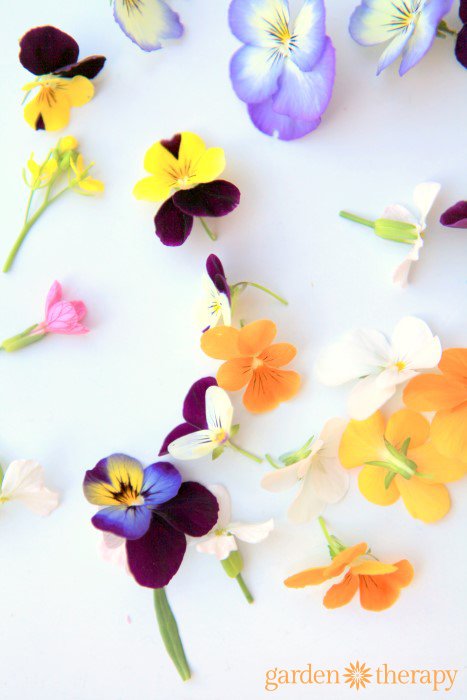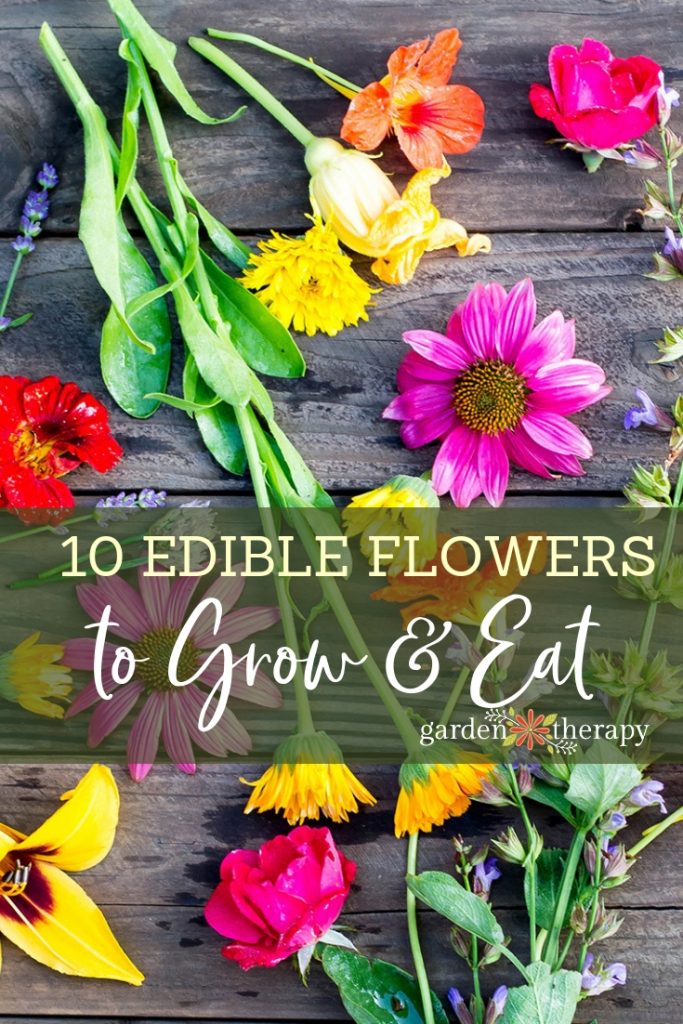Why decorate with sprinkles when you have petals? There are so many scrumptious and zesty edible flowers out there to try. Check out this guide on how to grow edible flowers and which ones are my favourite to include in cooking, cake decorating, or simply because they are just too pretty not to have!
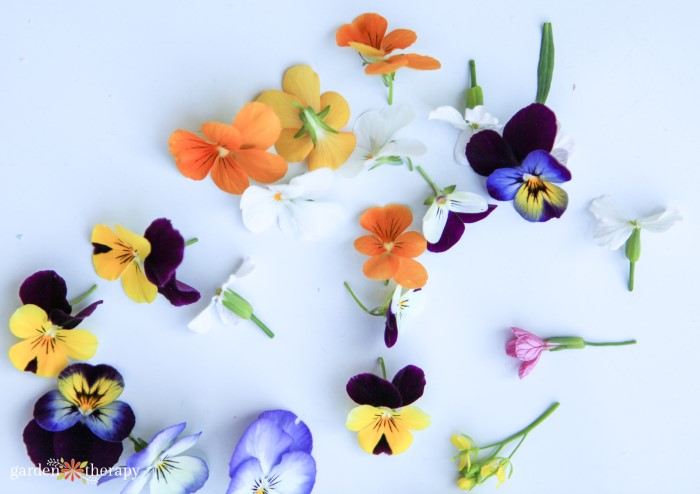
Who doesn’t love to get a beautiful bouquet of blooms or gaze upon a field of wildflowers? A flower’s main job is to be pretty—they need to attract pollinators in order to produce seeds. Not only do they beautify your garden, but they can also add aesthetics and exotic flavours to your meals.
Yes, I did say flavours! Edible flowers are so underrated and a missed element from many dishes. They offer many unique flavours and a little bit of fun. I always wonder why more people don’t use them. After reading this list of edible flowers, I’m sure you’ll start adding them to your recipes in no time.
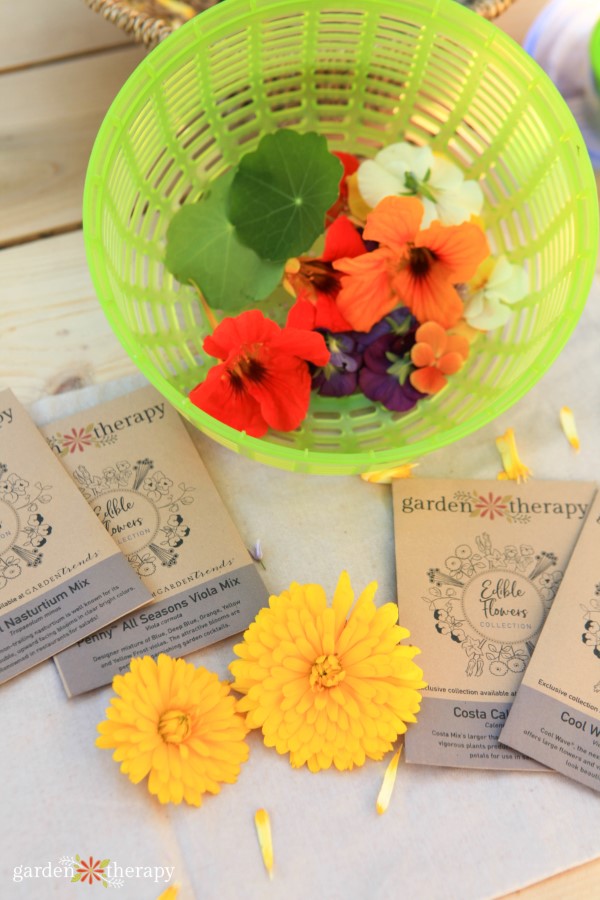

What Do Edible Flowers Taste Like?
There is a whole world of edible flowers to open your taste buds to. Just like herbs, there are many brilliant and unique flowers to explore.
Some edible flowers have tart, bitter, and spicy flavours that add some kick to salads and savory dishes. This includes nasturtiums, chive, echinacea, and more. Others have a sweetness that adds punch to your dishes such as rose, lavender, and dandelion.
The best way to get a true sense of their flavour is to start tasting them!
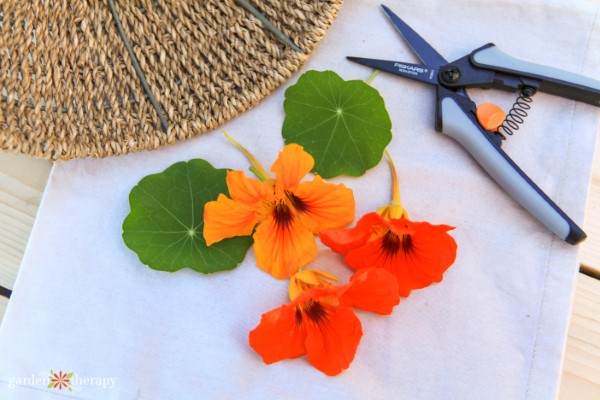

How to Grow Edible Flowers
Growing edible flowers doesn’t differ much from growing herbs or other herbaceous plants. Most you can start from seed, but a few are best purchased from a garden centre.
To grow from seed, start off with a sterile seed-starting mix. Label your sprouts as they will all look the same at first. Keep the top layer of your soil most at all times and be careful not to overwater it and make it soggy. You also want to avoid washing out or damaging seedlings.
Once they start to grow, avoid overcrowding by snipping all but the strongest seedling in each pot. Don’t pull or you risk disrupting the roots. If you are having trouble getting sprouts, sometimes a window isn’t enough light. Consider placing sprouts under a grow light or try to mimic greenhouse conditions with a plastic covering.
When your plants are big and strong, harvest the flowers for recipes at peak of freshness. This is when they have fully bloomed but before they wilt. Harvest with sharp, clean scissors during the cool parts of the day such as early morning or evening. Use them the day you harvest and place them in the fridge until you’re ready to enjoy them.
Where to Buy Edible Flowers?
Don’t feel like growing them yourself? No problem! There are a few places where you can source edible flowers. The first place I always recommend checking is farmer’s markets. You can chat directly with the sellers to learn about the flowers and how they were grown.
You can also look for blooming herbs as they will be edible. Check out the produce section (not the floral section!) of your local grocery store.
You can also order candied flowers online or search for local growers using a search engine. Personally, I always prefer to grow my own. This way I know there were no pesticides used and they are completely safe to eat.
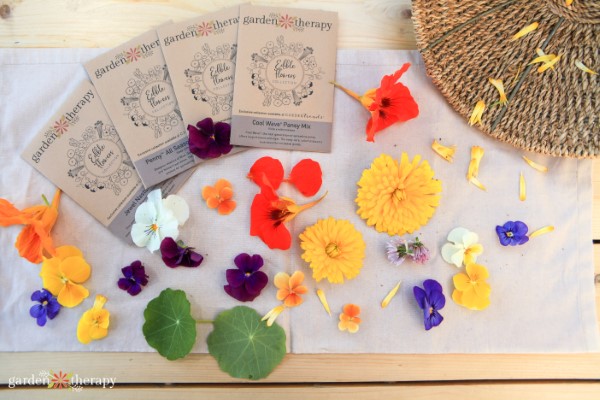

10 Edible Flowers for Your Garden
There are many garden flowers you can eat. However, before you consume any flower, take heed of these guidelines:
- Eat flowers only when you are positive that they are edible. Some flowers look VERY similar. Be sure to have a positive ID first.
- Only eat flowers that were grown organically. Many plants you purchase from retailers have been sprayed with pesticides.
- Thoroughly wash all flowers before you consume them. You can see my method of washing fruits, veggies, and flowers here.
- For most flowers, only consume the petals.
- If in doubt that the flower is edible, skip it.
If you are looking for a list to get you started, here are 10 edible flowers to try:
1. Nasturtiums
This is a popular edible flower that takes well to containers. Nasturtiums are available in trailing or upright varieties and their colour range is reminiscent of a brilliant sunset (think oranges, reds, and yellows).
Nasturtium seedlings are best planted in the spring in warm soil. They do require darkness in order to germinate, so I like to get them started indoors. Once the seedlings have been thinned and are ready to be transplanted outdoors, plant them in a full sun location. Nasturtiums are hardy in zones 9-11 but are treated as annuals in zones 4-8. They cannot survive freezing temperatures.
All parts of nasturtium are edible: petals, leaves, and seeds. The leaves have a peppery, spicy flavour; a cross between watercress and radish. The flowers are a tad milder and sweeter. I enjoy making a nasturtium-infused vinegar to use for salads and dipping bread.
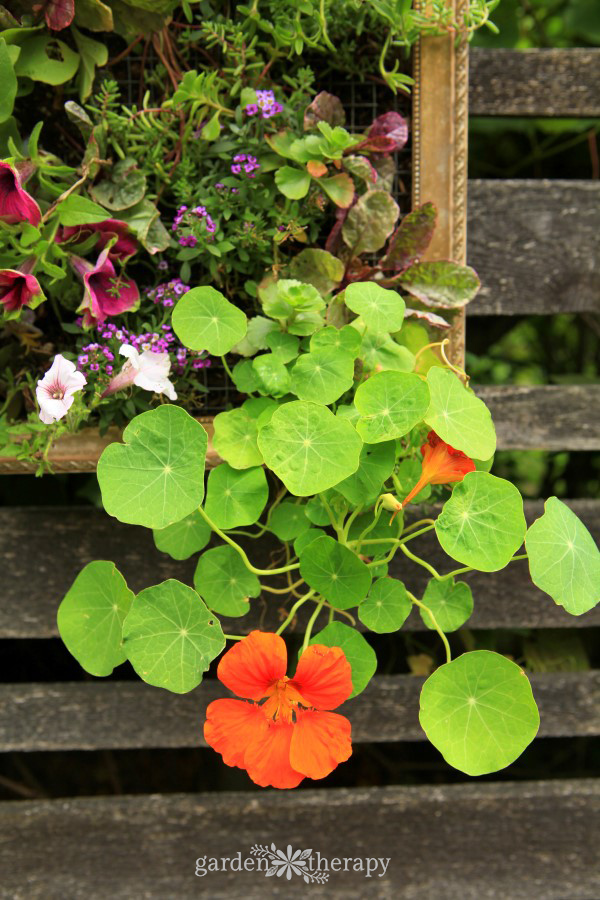

2. Roses
Are roses edible? Yes! The quintessential flower of love, roses offer a sweet flavour with a slight spice. All parts of the rose are edible.
The leaves are good for including in tea, tasting similar to black tea. The rosebuds have the most rose flavour. Dry them and use them in tea or to flavour other dishes. You can also pick rose petals to add to salads, infuse in honey, garnish desserts, and so much more.
The intensity of flavour will depend on the type, colour, and soil conditions. The darker the petals, the more pronounced the flavour. All roses are edible, but before consuming, remove the bitter white portion of the petals.
Lastly, rose hips are full of antioxidants and have more vitamin C than oranges. They have a zesty crab apple taste, though are a little less tasty. Harvest when they are fully orange or red, not green, and cut them in half to scrape out the seeds. Read more in my herbal guide to rosehips.
Most roses are purchased in a container or as a dormant root plant. Be sure to choose a disease-resistant variety as roses are very disease-prone. Plant your rose plant in fall before the frost or in spring after the fear of frost has passed. Choose a site with well-drained soil and full sun. However, warm climates will want to protect the plant from those hot afternoons.
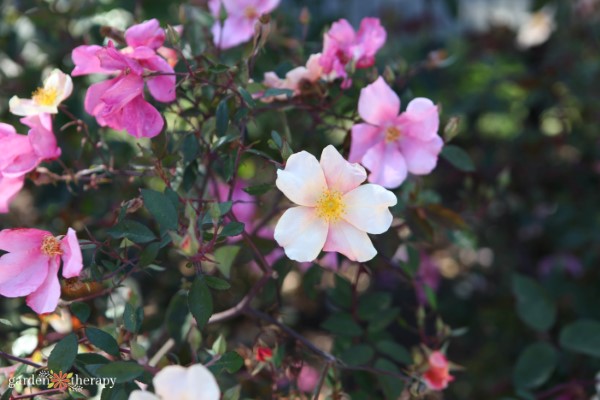

3. Calendula
Also known as “poor man’s saffron,” calendula flavour ranges from spicy to bitter and tangy to peppery. This flower is also a skin-healing powerhouse. Calendula’s colour can vary greatly in a diverse range of yellows and oranges and the petals add a yellow tint to food and a saffron-like flavour, hence its nickname.
Plant your calendula in the spring in a location with partial to full sun. You can also directly sow your seeds in early autumn if you live in zones 8-10. Calendula likes cool weather and does well in zones 2-10.
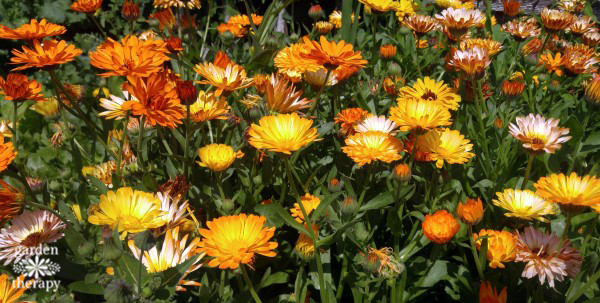

4. Daylily
This tough ornamental is a favorite in landscapes because it is a prolific and ornamental bloomer. Daylilies come in numerous shades of yellow, red, orange, purple, and white and bloom from spring through summer. A perennial, plant in late spring or early fall. They do well in zones 3-9, love all soil conditions, and require full sun.
Daylilies have a mild vegetable flavour similar to asparagus. Remove the bitter white base of the bloom before you eat them. Also please be sure that you are tasting a daylily (hemerocallis), as other lilies can be toxic and can make you quite sick.
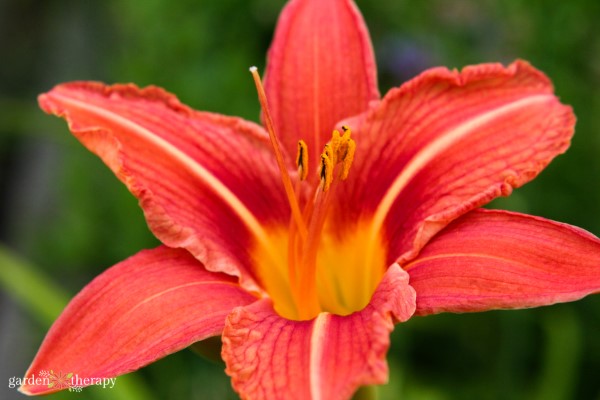

5. Lavender
I’m sure you are familiar with the soothing properties of lavender’s scent. The flowers of this popular herb are used for a multitude of DIY beauty products.
Lavender is difficult to grow from seed (though not impossible) and is best grown from cuttings or purchased from the garden centre. Lavender loves cool winters and hot, dry summers. Most varieties are hardy in zones 5-9 but check your specific variety. Lavender like well-drained soil and lots of sun.
Like all herb flowers, lavender blooms are edible. They have a distinctive floral taste with a hint of rosemary/mint combo. Use sparingly in sweet dishes; a little goes a long way.
Truthfully, you can never grow too much lavender! There are so many uses for this herb flower! Here are 18 Soothing Ways to Use Lavender at Home
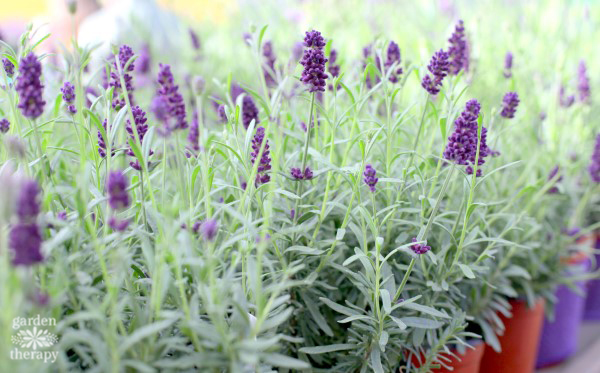

6. Chive
All allium (onion family) blossoms are edible. Their flavour is typically milder than the foliage. Chive blooms have a delicious onion essence and pretty little purple petals. Harvest the blooms along with the foliage and add to salads or make a lovely chive vinaigrette.
To grow chives, plant seeds in early spring for a late spring/early summer harvest. They like the cool seasons so they grow best in the spring and fall, remaining dormant for the summer. Place your chives in moist, well-draining soil in partial to full sun. Chives do best in zones 3-9.
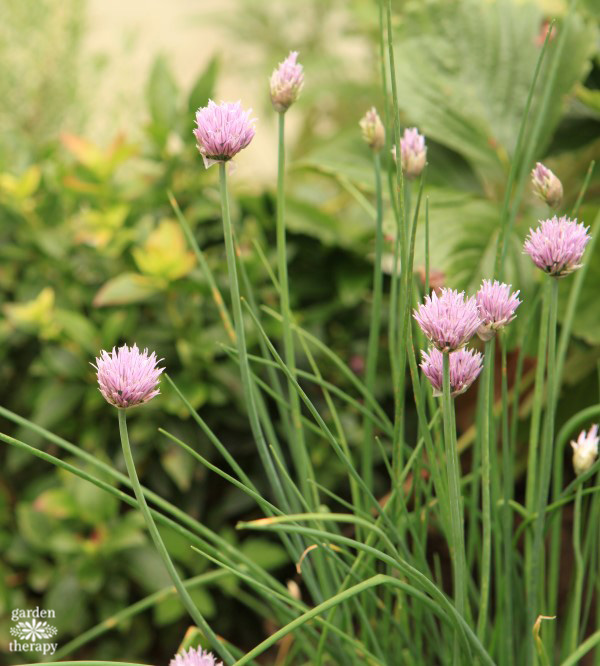

7. Echinacea
Commonly known as coneflower, echinacea is a well-known medicinal herb. Its powerful healing properties have made this herbaceous plant a popular home remedy for colds.
Echinacea is wonderful to grow as it is drought tolerant and doesn’t mind being planted in poor soil. It loves bright light but will also tolerate the shade (but may bloom less there). Begin planting your echinacea in early spring or early fall in zones 3-9.
Although most of its power is in the roots and seed head, the petals are edible and will add a colourful splash to your dishes with the added benefit of its healing properties. They have a very floral taste and are often mixed with other herbs and sweeteners to better the flavour.
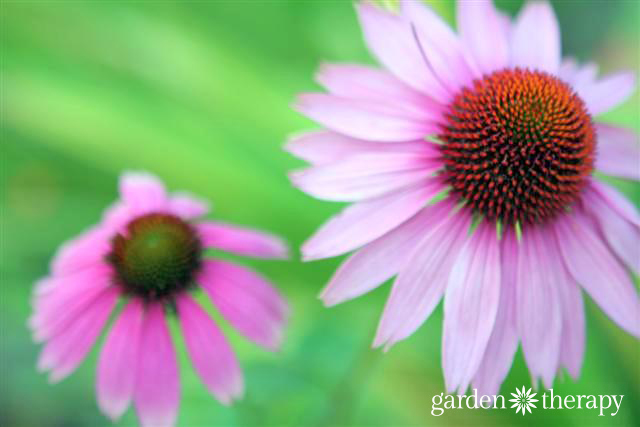

8. Squash Blossoms
If you don’t like squash, perhaps you’ll like their blossoms! Plant your squash in late spring and sow directly in warm soil in zones 3-10. One neat trick for growing squash is to grow them in hills. Plant three 3 seeds per hill and thin them into 2 strong plants later. Make your tiny hills in a square pattern.
The blooms of all types of squash are edible, but the most popular ones come from the male flower of the zucchini and crookneck squash. The blooms have a mild squash taste and can be eaten raw in a salad or stuffed with ricotta and batter fried.
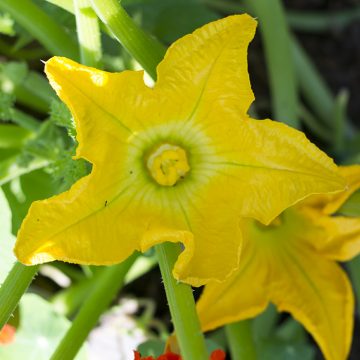

9. Dandelion
The bane of perfect, green lawns is the humble dandelion. What most people don’t know is it super nutritious and one of the best greens you can eat.
However, you still want to make sure you control the dandelion when growing it. Plant your dandelion in a container in early March all the way through to September. They are perennials and will grow well in zones 3-9.
This tenacious weed is entirely edible. Dandelion blooms taste the sweetest when picked young; they offer a honey-like flavour. Avoid mature blooms, as they tend to be bitter. Try frying dandelion blooms in tempera batter and oil. They are crunchy, savoury, and delicious!
The leaves can also be eaten, tasting like spicier arugula. They are best eaten in the spring when the plant is young and before they flower.
I grew up picking and eating dandelions. I knew they were tasty but had no idea how good they were for you! Read more about this surprising superfood and see what I mean.
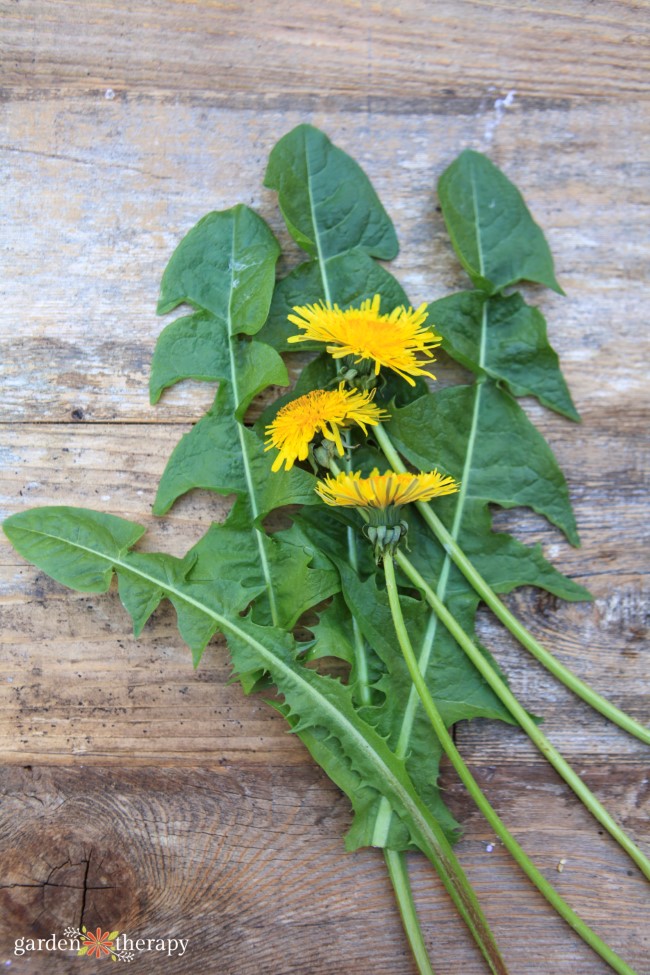

10. Viola (Pansy, Viola, & Violets)
These cool-weather favorites add brightness to planters, lollipops, ice cubes, AND cupcakes! They have a sweet, grassy/green flavour. Violas come in a plethora of colour ranges, which makes them a fun flower to use as garnishes.
Violas love cool weather and will die back in the hot heat. Plant violas in late winter for early spring and summer flowering or plant in fall for fall flowering. They like partial to full sun and do well in zones 3-8.
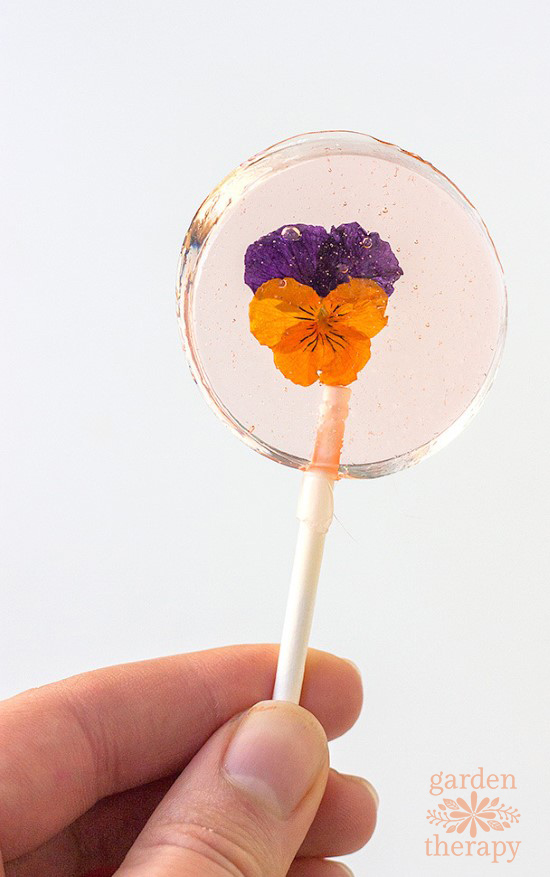

Best Edible Flowers for Cake
Using edible flowers for cake is a gorgeous and natural way to brighten up and decorate the icing. When decorating a cake, choose flowers that are colourful and easy to use such as violas, lavender, rose, calendula, and nasturtiums.
It is best to pick the flowers fresh for the cake. Alternatively, you can place them in the fridge beforehand to prevent them from wilting or candy your flowers for easy, long-lasting decoration.
Only use the petal parts of the flower and thoroughly wash and dry before using them on the cake. If you are ever unsure about whether or not a flower is safe, always be safe rather than sorry.
Edible Flower FAQ
The first thing I do when I buy an edible flower from the garden centre is remove all the flowers. These have been sprayed with pesticides, herbicides, and other chemicals and are not safe to eat. Any new flowers that grow while in my care I know are safe to eat since I didn’t put anything on them. I break this down into more detail in this post.
Sometimes, they’ll have a label saying “not safe for consumption”, which likely means it has had chemicals sprayed on them.
I like to harvest my edible flowers just before I use them as a garnish, as that’s when they’ll look their best. If you want to make them last, keep them in an airtight container with a wet piece of paper towel and put them in the fridge. This can help them last an extra day or two.
This list is just the tip of the iceberg of edible flowers. Remember to do your research before you eat any flowers. Also, just because you can eat them doesn’t mean you should. Sometimes, consuming vast amounts of blooms will not sit too kindly in your digestive tract.
More Posts About Edible Flowers

